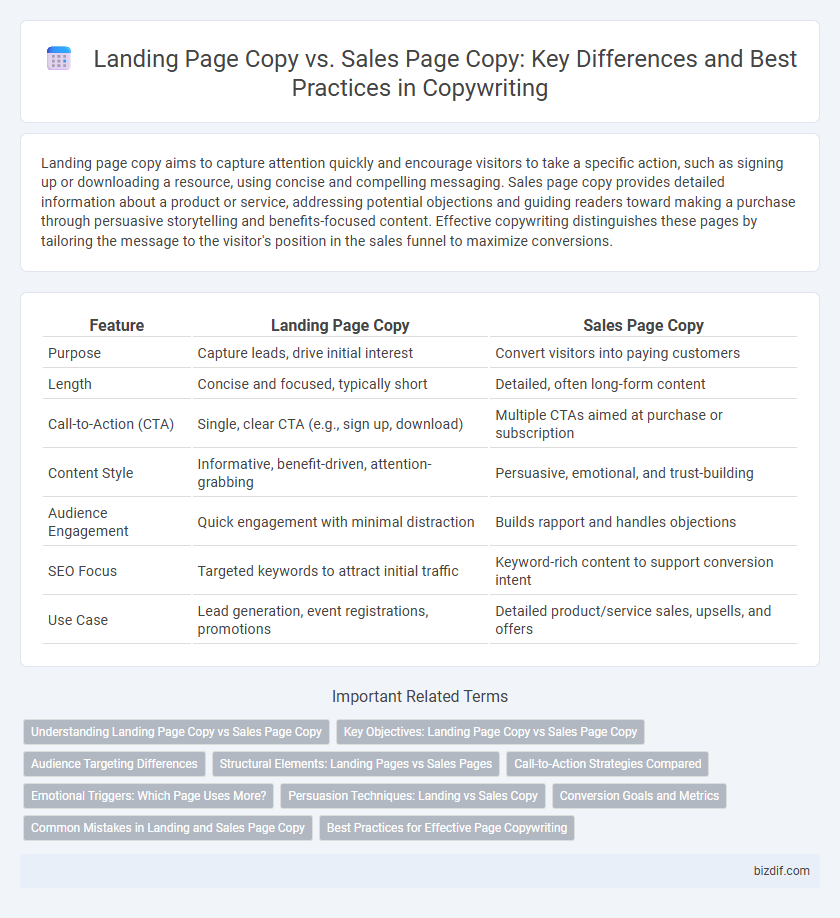Landing page copy aims to capture attention quickly and encourage visitors to take a specific action, such as signing up or downloading a resource, using concise and compelling messaging. Sales page copy provides detailed information about a product or service, addressing potential objections and guiding readers toward making a purchase through persuasive storytelling and benefits-focused content. Effective copywriting distinguishes these pages by tailoring the message to the visitor's position in the sales funnel to maximize conversions.
Table of Comparison
| Feature | Landing Page Copy | Sales Page Copy |
|---|---|---|
| Purpose | Capture leads, drive initial interest | Convert visitors into paying customers |
| Length | Concise and focused, typically short | Detailed, often long-form content |
| Call-to-Action (CTA) | Single, clear CTA (e.g., sign up, download) | Multiple CTAs aimed at purchase or subscription |
| Content Style | Informative, benefit-driven, attention-grabbing | Persuasive, emotional, and trust-building |
| Audience Engagement | Quick engagement with minimal distraction | Builds rapport and handles objections |
| SEO Focus | Targeted keywords to attract initial traffic | Keyword-rich content to support conversion intent |
| Use Case | Lead generation, event registrations, promotions | Detailed product/service sales, upsells, and offers |
Understanding Landing Page Copy vs Sales Page Copy
Landing page copy primarily aims to capture attention and encourage visitors to take a specific action, such as signing up or downloading a resource, using concise and persuasive messaging. Sales page copy, by contrast, provides detailed information, addresses objections, and builds trust to drive purchases with a compelling narrative and extensive benefits presentation. Understanding the distinct goals and structure of each copy type enhances conversion rates and marketing effectiveness.
Key Objectives: Landing Page Copy vs Sales Page Copy
Landing page copy aims to capture visitor attention and drive immediate action, such as signing up or clicking through, by highlighting key benefits and clear calls to action. Sales page copy goes deeper, addressing objections, providing detailed product information, and persuading potential customers to complete a purchase. Both prioritize conversion optimization but differ in length, detail, and intent to guide users through distinct stages of the sales funnel.
Audience Targeting Differences
Landing page copy targets a broad audience by capturing initial interest and encouraging exploration, often using concise messaging to appeal to visitors with varied intents. Sales page copy focuses on a specific, well-defined audience ready to make a purchase, using persuasive language, detailed benefits, and strong calls to action. Understanding these audience targeting differences ensures tailored messaging that maximizes conversion rates for each page type.
Structural Elements: Landing Pages vs Sales Pages
Landing page copy focuses on concise headlines, clear call-to-action buttons, and minimal distractions to capture visitor attention and drive immediate interaction. Sales page copy incorporates detailed product descriptions, persuasive storytelling, testimonials, and multiple calls-to-action to nurture interest and facilitate purchase decisions. Both use structured layouts, but landing pages prioritize simplicity for lead generation, while sales pages emphasize comprehensive information to convert prospects.
Call-to-Action Strategies Compared
Landing page copy utilizes concise, value-driven calls-to-action (CTAs) designed to capture visitor interest quickly, such as "Get Started" or "Download Now," optimizing conversion rates through simplicity and urgency. Sales page copy employs more persuasive, benefit-focused CTAs like "Buy Now to Unlock Exclusive Bonuses," integrating storytelling and social proof to build trust and compel immediate purchasing decisions. Effective CTA strategies balance clarity and motivation, with landing pages emphasizing low-commitment actions and sales pages driving direct sales through emotionally charged prompts.
Emotional Triggers: Which Page Uses More?
Sales page copy employs more emotional triggers than landing page copy by deeply addressing pain points, desires, and objections to drive conversions. Landing pages often focus on concise messaging and clear calls-to-action, using fewer emotional appeals to maintain user attention. Emotional triggers like storytelling, urgency, and social proof are heavily utilized in sales pages to foster trust and motivate purchases.
Persuasion Techniques: Landing vs Sales Copy
Landing page copy uses concise, benefit-driven headlines and clear calls-to-action to quickly capture visitor interest and encourage immediate engagement. Sales page copy employs detailed storytelling, social proof, and emotional triggers to build trust and persuade potential customers through a longer, more immersive experience. Both techniques rely on persuasive elements but differ in depth and intent, with landing pages focusing on conversions and sales pages aimed at closing sales.
Conversion Goals and Metrics
Landing page copy focuses on capturing visitor attention and encouraging immediate actions like sign-ups or lead generation, with conversion metrics such as click-through rates and bounce rates being key indicators. Sales page copy aims to persuade potential customers through detailed benefits, overcoming objections to drive purchases, measured by sales conversion rates and average order value. Both types of copy require clear calls-to-action tailored to their specific conversion goals to optimize overall campaign effectiveness.
Common Mistakes in Landing and Sales Page Copy
Common mistakes in landing and sales page copy include unclear value propositions, overly complex language, and lack of targeted calls to action, which reduce conversion rates. Neglecting audience segmentation leads to generic messaging that fails to resonate with specific customer needs and pain points. Additionally, ignoring essential SEO elements and emotional triggers diminishes the page's effectiveness in driving user engagement and sales.
Best Practices for Effective Page Copywriting
Landing page copy should prioritize clarity and concise messaging that drives a single, focused call-to-action, leveraging persuasive headlines, benefit-oriented language, and trust signals like testimonials. Sales page copy requires a deeper emotional connection, incorporating storytelling, detailed product descriptions, and addressing objections to nurture potential customers through the buying journey. Using strong, action-oriented language and clear value propositions tailored to the target audience enhances conversion rates across both types of page copy.
Landing Page Copy vs Sales Page Copy Infographic

 bizdif.com
bizdif.com